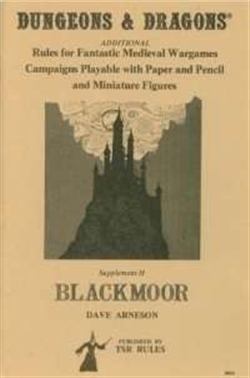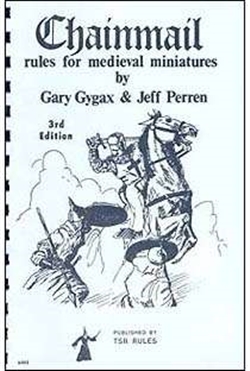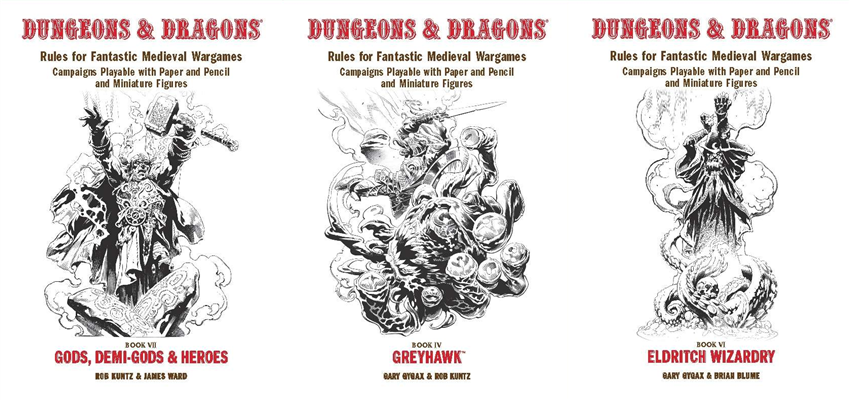“Inspiration for all the fantasy work I have done stems directly from the love my father showed when I was a tad, for he spent many hours telling me stories he made up as he went along, tales of cloaked old men who could grant wishes, of magic rings and enchanted swords, or wicked sorcerors [sic] and dauntless swordsmen.”
—E. Gary Gygax, 1979, AD&D Dungeon Masters Guide, p. 224
Happy Birthday, Gary Gygax! To many, Gygax is the father of roleplaying games. Many wargamers came before him, and many joined him on this effort, but Gary Gygax and Dave Arneson’s joint creation of Dungeons & Dragons gave birth to the RPG genre.
On this day, we celebrate the birth of the founder of our hobby, and look back at the story of its creation. Where did D&D come from? What inspired Gygax and Arneson to create this game that has become not just a hobby but a lifestyle for so many people? Could they have possibly anticipated the success of the fifth edition of their game, or that it would ever become a mainstream sensation that attracts not just Hollywood actors, but millions upon millions of normal people like you and me to play this game, and even broadcast their gameplay online for others’ enjoyment?
This is the story of the creation of D&D. It is the story of telling stories. And it is the story of creating storytellers.
This story owes a debt of gratitude to Shannon Appelcline, whose exhaustive documentation of the history of roleplaying games in his four-book series Designers and Dragons: A History of the Roleplaying Game Industry, was an essential source for this article. Its first volume, detailing the birth of the hobby in the 1970s, is essential reading for anyone interested in the history of D&D and its contemporaries.
Wargaming
 Dungeons & Dragons is descended from tactical military simulations, historically known as wargames. Wargaming has a long history in Europe and America, dating back to tactical drills played by military officers to train soldiers as strategists in the 17th century, and the wargaming hobby was introduced to the United States in 1953 when Charles Roberts created Tactics, the first major wargame in the USA. Tactics was self-published by Roberts’ own company, The Avalon Game Company. This company would be renamed Avalon Hill in 1958, and would go on to be the premiere tactical game company in America. Perhaps its best known game was Diplomacy, which focused on negotiation between players who commanded the belligerent nations of World War I. Avalon Hill’s other wargames tended to focus on real-life battles, such as Midway, based on the eponymous WWII battle.
Dungeons & Dragons is descended from tactical military simulations, historically known as wargames. Wargaming has a long history in Europe and America, dating back to tactical drills played by military officers to train soldiers as strategists in the 17th century, and the wargaming hobby was introduced to the United States in 1953 when Charles Roberts created Tactics, the first major wargame in the USA. Tactics was self-published by Roberts’ own company, The Avalon Game Company. This company would be renamed Avalon Hill in 1958, and would go on to be the premiere tactical game company in America. Perhaps its best known game was Diplomacy, which focused on negotiation between players who commanded the belligerent nations of World War I. Avalon Hill’s other wargames tended to focus on real-life battles, such as Midway, based on the eponymous WWII battle.
Interestingly, Avalon Hill is now a subsidiary of Wizards of the Coast.
Gary Gygax of Lake Geneva, Wisconsin, and Dave Arneson of the Twin Cities region in Minnesota, were both introduced to hobby gaming through Avalon Hill’s historical wargame Gettysburg in the late ‘50s and early ‘60s. Gettysburg inspired them both to begin designing their own games. Gygax became well-known within the wargaming field by joining the International Federation of Wargamers (IFW) and writing for several wargame fan publications. Arneson, on the other hand, played wargames with a group of close friends in the Twin Cities. His wargames were run by Dave Wesely, who created a Napoleonic-era wargame campaign named Braunstein—but unlike traditional wargames where players controlled squadrons of soldiers or even entire armies, Wesely’s players each assumed the role of a single character who had an objective within the battle, which Wesely adjudicated himself rather than simply consulting dice tables.
In this way, Dave Wesely’s Braunstein scenarios could be called the first American roleplaying game, and Wesely himself the first Game Master.
Chainmail and Blackmoor
 Gygax and Arneson first met in Lake Geneva at the second Gen Con in 1969, and their friendship led to the creation of Don’t Give up the Ship in 1971, a naval wargame based on rules they had created to expand Wesely’s own land-based Napoleonic wargames. Between Gygax and Arneson’s meeting in ’69 and their first publication in ’71, Gygax worked on other projects with fellow members of the IFW to create a medieval miniatures game known as Chainmail, originally based on a four-page rules pamphlet designed by Jeff Perren. Chainmail was a remarkable wargame because it reduced the scale of combat from armies and platoons to single fighters, often engaged in “man-to-man combat”—not unlike Wesely’s Braunsteins. Chainmail would eventually expand from purely historical medieval combat into fantasy combat featuring, among other things, wizards who wielded now-familiar spells like fireball and phantasmal force. Despite these innovations, Chainmail was still a wargame first and foremost. Its wizards were individuals, but they were not characters. They were a military unit of a single person, rather than of many soldiers.
Gygax and Arneson first met in Lake Geneva at the second Gen Con in 1969, and their friendship led to the creation of Don’t Give up the Ship in 1971, a naval wargame based on rules they had created to expand Wesely’s own land-based Napoleonic wargames. Between Gygax and Arneson’s meeting in ’69 and their first publication in ’71, Gygax worked on other projects with fellow members of the IFW to create a medieval miniatures game known as Chainmail, originally based on a four-page rules pamphlet designed by Jeff Perren. Chainmail was a remarkable wargame because it reduced the scale of combat from armies and platoons to single fighters, often engaged in “man-to-man combat”—not unlike Wesely’s Braunsteins. Chainmail would eventually expand from purely historical medieval combat into fantasy combat featuring, among other things, wizards who wielded now-familiar spells like fireball and phantasmal force. Despite these innovations, Chainmail was still a wargame first and foremost. Its wizards were individuals, but they were not characters. They were a military unit of a single person, rather than of many soldiers.
Dave Arneson was the man who introduced the idea of roleplaying to Gygax. Returning to 1971, Dave Arneson, now tired with Napoleonic wargaming, decided to launch a “medieval Braunstein” based on the individual characters of Wesely’s Braunsteins and the medieval fantasy combat rules of Gygax’s Chainmail. This campaign was titled Blackmoor (a name similar to Braunstein, meaning brown stone in German, and which would later inspire Gygax’s own Greyhawk campaign), and followed the adventures of a group of characters who gained experience over the course of many sessions of play and fought many battles in a story that progressed from session to session.
In 1972, Arneson and his fellow Blackmoor players returned to Gen Con to triumphantly present it to Gygax and their fellow wargamers in Lake Geneva. Gygax went on to collaborate with Arneson on an expansion of the Blackmoor rules, and over the next year, Gygax produced a draft of a game called Men & Magic—or perhaps Swords & Spells—or perhaps still Treasure & Trolls—or maybe, just maybe…
Dungeons & Dragons
In order to publish Dungeons & Dragons—the name Gygax and Arneson finally settled upon for their fantasy game—Gary Gygax and his childhood friend Don Kaye threw their last bits of cash into forming a company called Tactical Studies Rules, or TSR, in order to publish their ambitious game. It was at this point that Dave Arneson began drift apart from D&D. He had no money to invest in the fledgling TSR, and he remained unaffiliated with Gygax’s company for years, despite being D&D’s co-creator. Further, Arneson and Gygax had clashed repeatedly during D&D’s development, with the headstrong Gygax often moving forward, supposedly against Arneson’s wishes.
Nevertheless, D&D was published. And despite the nascent TSR’s financial troubles, it sold. And it sold well, remarkably well for an untested offshoot of the vanishingly niche miniature wargaming hobby.
ONCE UPON A TIME, long, long ago there was a little group known as the Castle and Crusade Society. Their fantasy rules were published, and to this writer’s knowledge, brought about much of the current interest in fantasy wargaming. For a time the group grew and prospered, and Dave Arneson decided to begin a medieval fantasy campaign game for his active Twin Cities club. From the map of the “land” of the “Great Kingdom” and environs — the territory of the C & C Society — Dave located a nice bog wherein to nest the weird enclave of “Blackmoor,” a spot between the “Great Kingdom” and the fearsome “Egg of Coot.” From the CHAINMAIL® fantasy rules he drew ideas for a far more complex and exciting game, and thus began a campaign which still thrives as of this writing! In due course the news reached my ears, and the result is what you have in your hands at this moment.
—E. Gary Gygax, 1973, from Dungeons & Dragons Volume 1: Men & Magic
Gygax and TSR would go onto publish many other wargames before truly comprehending the scope of D&D’s success. But TSR also went on to publish some of the first-ever D&D adventures, including scenarios by Gary Gygax now considered classics such as the Against the Giants series (1978), Tomb of Horrors (1978), The Village of Hommlet (1979), and The Keep on the Borderlands (1979).
Over the next four years, TSR would be restructured into TSR Hobbies Inc., and Arneson would move to Lake Geneva in 1976 to become its research director—only to depart the company before the end of the year. Arneson was used to the fan-driven, hobbyist nature of miniature wargaming, and was disturbed by the commercial direction of TSR’s business plan. Interestingly, by this point, TSR was no longer Gygax’s company; even though Gygax was CEO, he only held 30% of TSR’s stock. His business partner Brian Blume and Brian's father Melvin Blume, were the majority shareholders. Even if Gygax wanted to cater to Arneson’s hobbyist inclinations, the decision was now all but completely out of his hands.

Advanced Dungeons & Dragons
TSR released a new edition of Dungeons & Dragons in 1977. In fact, two new editions were being created at once. One was J. Eric Holmes’s Dungeons & Dragons Basic Set, which was essentially a cohesive and unified revision of the game created by Gygax and Arneson. The second, known as Advanced Dungeons & Dragons (AD&D), was produced by Gygax himself. AD&D was separated into four hardcover books: the Player’s Handbook, Monster Manual, and Dungeon Master’s Guide—a tradition that has been replicated by AD&D’s descendants for decades—plus a final book, Deities and Demigods. As Gygax’s creation, AD&D went on to become the “official” version of D&D. It received a 2nd edition in 1987, and by the time its 3rd edition was produced by Wizards of the Coast in 2000, it was so ubiquitous that AD&D was simply known as “Dungeons & Dragons.”
As this new edition was made following Arneson’s departure from TSR, Gygax declared the game his own creation and excluded Arneson from any royalties related to AD&D as a separate entity from the original Gygax & Arneson D&D books. Arneson sued TSR in 1979. While he emerged victorious, the lawsuit over AD&D (and a second lawsuit over the AD&D Monster Manual II) ended the partnership between Gygax and Arneson for good.
The story of Gygax and Arneson ultimately ended in tragedy for both men. Brian Blume’s brother, Kevin Blume, became the new COO of TSR by buying out his father’s stock, and dozens of TSR employees were laid off in the wake of his ascension. Some voiced support for Arneson and disdain for Gygax and the Blumes, but the Blumes were no friends of Gygax’s, either. In 1982, Kevin Blume forced Gygax to step down from TSR’s board and supplanted him as CEO. Gygax remained with TSR for the next 3 years, but his influence over the company only waned—with a brief but glorious resurgence in 1985 with the release of Unearthed Arcana and other major hardcover books—until he finally left TSR, defeated, on the final day of 1985.
The Founders’ Legacy
 TSR ultimately crumbled under the weight of its debts in 1997, and its pieces were picked up by Wizards of the Coast—then known primarily for publishing card games like Pokémon and Magic: the Gathering. Gygax’s AD&D was published under the TSR logo for three more years, until Wizards dropped the TSR logo (as well as the “Advanced” moniker) for good with the publication of third edition Dungeons & Dragons.
TSR ultimately crumbled under the weight of its debts in 1997, and its pieces were picked up by Wizards of the Coast—then known primarily for publishing card games like Pokémon and Magic: the Gathering. Gygax’s AD&D was published under the TSR logo for three more years, until Wizards dropped the TSR logo (as well as the “Advanced” moniker) for good with the publication of third edition Dungeons & Dragons.
Nevertheless, Gary Gygax remains an icon of the roleplaying game field. His contributions to the hobby cannot be overstated, and his legacy is secure in countless media tributes in shows ranging from The Colbert Report to Futurama, as well as gaming conventions like Gary Con, which is held every year in his home town of Lake Geneva, Wisconsin. His son, Luke Gygax, remains close to D&D, as shown by his appearance on GM Tips with Satine Phoenix on Geek & Sundry, at the Stream of Many Eyes in June 2018, and on this Saturday, July 28th on the Founders & Legends stream, starting at 10 AM Pacific.
Dave Arneson’s role in the creation of D&D is less well-remembered, but his contributions to roleplaying games deserve as much celebration as Gygax’s. D&D’s current resurgence as a storytelling and entertainment medium would not be possible without Arneson’s vital element of character-driven roleplaying.
Happy Founder’s Day! Never forget from what humble beginnings our hobby sprung, and may we always carry the spirit of innovation in gaming pioneered by our hobby’s grandfathers.
Gary Gygax passed away on March 4th, 2008. Dave Arneson followed shortly thereafter on April 7th, 2009.
Information in this article was sourced from Designers & Dragons: The ‘70s by Shannon Appelcline. Images were sourced from the Dungeon Masters' Guild and are copyright Wizards of the Coast.
 James Haeck is the lead writer for D&D Beyond, the co-author of Waterdeep: Dragon Heist and the Critical Role Tal'Dorei Campaign Setting, and is also a freelance writer for Wizards of the Coast, the D&D Adventurers League, and Kobold Press. He lives in Seattle, Washington with his partner Hannah and his two feline writing assistants, Mei and Marzipan. You can usually find him wasting time on Twitter at @jamesjhaeck.
James Haeck is the lead writer for D&D Beyond, the co-author of Waterdeep: Dragon Heist and the Critical Role Tal'Dorei Campaign Setting, and is also a freelance writer for Wizards of the Coast, the D&D Adventurers League, and Kobold Press. He lives in Seattle, Washington with his partner Hannah and his two feline writing assistants, Mei and Marzipan. You can usually find him wasting time on Twitter at @jamesjhaeck.








-
View User Profile
-
Send Message
Posted Jul 27, 2018"Could they have possibly anticipated the success of the fifth edition of their game, or that it would ever become a mainstream sensation that attracts not just Hollywood actors, but millions upon millions of normal people like you and me to play this game...?"
Speak for yourself, my dude.
-
View User Profile
-
Send Message
Posted Jul 27, 2018Normal people as opposed to celebrities, that is. We're all geeks playing D&D together!
-
View User Profile
-
Send Message
Posted Jul 27, 2018Haha, I accept this interpretation!
-
View User Profile
-
Send Message
Posted Jul 27, 2018Good job, James! This is an accurate and coherent article. A great place to refer new players who are curious about the origins of the hobby. There's been a lot of overblown tripe written about this topic, it's refreshing to see something that's both brief and clear. You can leave the office early today!
-
View User Profile
-
Send Message
Posted Jul 27, 2018Great and fascinating article about the origins of the great game we all love.
I do feel however that the various Basic interations of D&D (the Holmes basic set, B/X, BECMI and the Rules Cyclopedia) deserves more than the mention they get in these portrayals of the origin of the game. For a lot of fans these games where the introduction to D&D through red or magenta box-sets (or books in some translated versions. My first RPG was a Norwegian translation of the Mentzer basic rules published in red book). Although i understand why it's neat to focus on Gygax and Arneson i just feel that the basic D&D game (because it was really a complete game alongside AD&D) deserves it's fair share of the credit for the phenomenon that D&D is today.
Looking forward to the Founders & Legend streams!
-
View User Profile
-
Send Message
Posted Jul 27, 2018Rest in peace Gary and Dave.
-
View User Profile
-
Send Message
Posted Jul 27, 2018Just wanna say, Diplomacy is about the WWI belligerents, and Midway was in WWII. Otherwise great article!
-
View User Profile
-
Send Message
Posted Jul 27, 2018Good catch! Fixed. What's a World War among friends?
-
View User Profile
-
Send Message
Posted Jul 27, 2018Agreed! I'd love to give the many iterations of Basic D&D the attention they deserve. In the meantime, Shannon Appelcline goes into greater detail on them both in Designers & Dragons: The ‘70s.
-
View User Profile
-
Send Message
Posted Jul 28, 2018There was a third guy too, who worked on it... right? He worked with Gary and Dave, but died before anything came of it. I remember something about his wife dropping off all his stuff in boxes, and thought that he had wasted his life on it. For the life of me I can't remember his name right now and it eludes a quick google search.
-
View User Profile
-
Send Message
Posted Jul 28, 2018R.I.P. Gary Gygax and Dave Arneson. The ones who changed my entire life for the better.
-
View User Profile
-
Send Message
Posted Jul 28, 2018This surely warrants further investigation. But who of our stalwart brethren will step up and scour the land? (I never learned to internet, so plz, someone... I'm curious about this one.)
-
View User Profile
-
Send Message
Posted Jul 28, 2018Thank you for such a great read!
I played my first game at the ripe old age of 9, that was 40 years ago, and I love this game as much now as I did then. Well almost as much. Hard to capture the wonder and excitement of youth.
Thank you to Gary and all of the other creators of this wonderful hobby/game. You have given my family and I countless hours of fun and adventure.
Take care and be well!!
-
View User Profile
-
Send Message
Posted Jul 28, 2018You're probably thinking of Don Kaye, who got a brief shout out in this article. He was the co-founder of TSR, along with Gary Gygax, and he cashed out his life insurance policy to invest in their new company. Don Kaye had, as far as I know, little to do with the actual design or development of D&D. His story is one of friendship with Gary and a love for hobby gaming. He suffered a fatal heart attack at age 37 and passed in January, 1975. Nevertheless, D&D kept rolling.
You might also be thinking of Jeff Perren, who created a four-page medieval miniatures wargame that Gary expanded into Chainmail. He's still alive today, though, so probably not.
(I've really pumped this book a lot by this point, but I'll give it one last push. If you want to know the serious history of TSR and the state of gaming at the birth of the hobby, you seriously have to get Designers and Dragons: A History of the Roleplaying Game Industry by Shannon Appelcline. Playing at the World by Jon Peterson is also an excellent account of this era.)
-
View User Profile
-
Send Message
Posted Jul 28, 2018The third person was Gary's friend, Don Kaye. His wife Donna wanted nothing to do with the 1/3 of TSR after Don's death of a heart attack that was left to her in his will.
-
View User Profile
-
Send Message
Posted Jul 29, 2018Don Kaye, that's it; thank you. I totally glossed over his mention in your article.
-
View User Profile
-
Send Message
Posted Jul 29, 2018Yeah, that's it; Don Kaye. It's sad; I wonder what happened to his wife.
Is it kind of dickish that I do giggle at the thought of 'Don and Donna Kaye' though? Lol
-
View User Profile
-
Send Message
Posted Jul 29, 2018For those interested in the history of D&D, especially newer players, I highly recommend the graphic novel "Rise of the Dungeon Master: Gary Gygax and the Creation of D&D" (https://www.wired.com/2017/05/rise-dungeon-master-gary-gygax-birth-dd/)
I had the fortune of meeting and speaking with Gary at Gen Con in the 80s. Prior to meeting him in person, my impressions were based on his television appearances where he defended "us" (it really felt like "we" were under attack) gamers against the ridiculous satanic-panic attacks. I was struck by how sincere and approachable he was.
I really hope a proper documentary can be made about him and I hope his memorial finally get's put up in Lake Geneva. It seems even attempts to honor him get cursed by acrimony and lawsuits. His memory deserves better.
-
View User Profile
-
Send Message
Posted Jul 29, 2018I’d also like to suggest the graphic novel “Rise of the Dungeon Master” by David Kushner and Koren Shadmi. Really an interesting and poignant illustrated history of D&D’s history. I really enjoyed it.